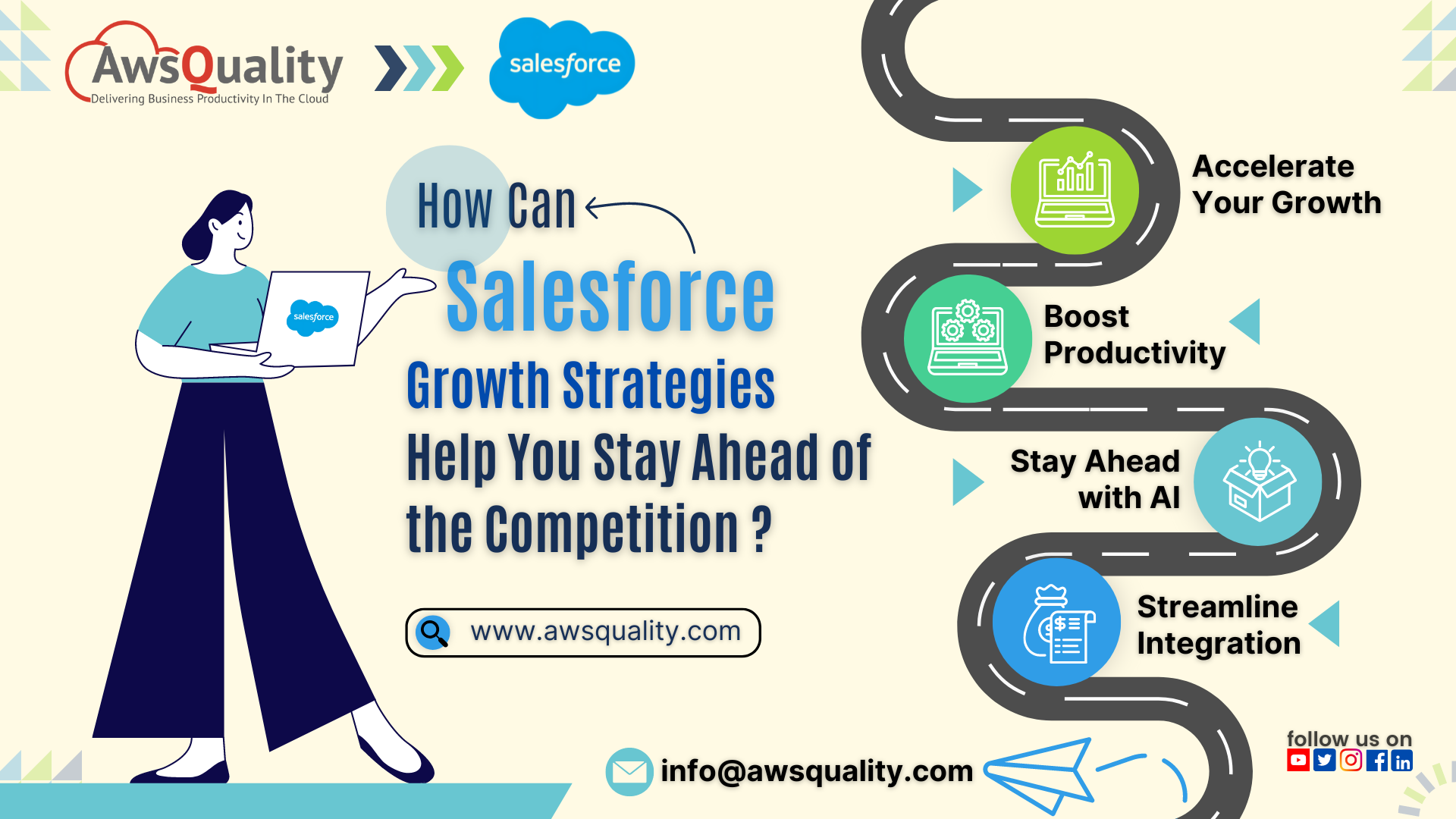
Unlock Success with Tailored Salesforce Growth Strategies, Expert CRM Consulting and Innovative Development Solutions for Lasting Business Impact.
In 2024, are you prepared to accelerate the growth of your company? Find out how Salesforce may be your ideal business partner! Imagine being able to easily synchronize your teams, increase output with state-of-the-art tools, and beat out the competition with insights powered by artificial intelligence. Examine the newest Salesforce growth strategy tactics and developments that are revolutionizing American organizations. This handbook contains the solutions, whether your goal is to improve CRM consulting or streamline company processes. Examine the entire post.
Salesforce uses a number of tactics to drive business growth. Let’s examine some crucial approaches and objectives:
1. Aligning Cross-Functionally:
Cross-functional alignment is a top growth-promoting strategy, per the State of Sales report. To explore new strategies and increase income, sales teams should work closely with other departments. As a leader in sales, think about allocating resources sensibly and positioning your group for success.
2. Frameworks for agility:
Being agile gives you a competitive edge. Motivate groups to quickly adjust to new sales strategies. Test your questions, messaging, and methods for handling objections on a regular basis. Get client input and design frameworks that assist every team member while taking into account the varying tastes of different generations.
3. Sales Productivity:
Make the most of sales engagement tools and efficient automation to prioritize productivity. Measurable gains in productivity can be achieved with a unified system.
4. Alternate Operating Models:
Prototype alternate operating models for erratic times. By customizing these tactics to your market and organizational strengths, you can position your business for expansion.
5. The business strategy
The business strategy of Salesforce aims to build stronger relationships with current clients, increase its worldwide go-to-market capabilities, enter new markets and verticals, fortify its partner network, and encourage robust customer adoption.
Accomplishing these objectives depends heavily on Salesforce’s CRM (Customer Relationship Management) products.
In what ways can I incorporate Salesforce into my current workflows?
Ensuring smooth data flow and effective operations requires integrating Salesforce with your current workflows. Consider the following best practices:
Begin with the roadmap and business strategy:
- Recognize your objectives for the project, your overall strategy, and your ROI expectations.
- Analyze gaps between the present and the future states.
Select the Appropriate Integration Pattern:
- Three patterns apply to Salesforce integration projects: middleware, API-led, and point-to-point.
- Select the strategy that best suits your needs.
Work together with the stakeholders:
- Early on, involve the pertinent teams (business, IT, etc.).
- List requirements and business scenarios.
Choose the Appropriate Integration Instruments:
- Make use of Salesforce’s extensive services and APIs.
- Think about the integration of data, business logic, and user interface.
Data Sync and Security Decisions:
- Choose the frequency of sync, data storage, and security.
- Evaluate maintainability and scalability.
Recall that a smooth integration improves your stack of technologies and facilitates data-driven decision-making.
What are some typical integration problems with Salesforce?
Projects involving the integration of Salesforce are not without difficulties. Let’s look at a few typical ones:
- Data Mapping: Accurate field and data structure mapping is necessary to provide smooth data transfer between systems.
- Duplicate Records: During integration, handling duplicates might be challenging. Use deduplication techniques to keep data accurate.
- Auto-ID Creation: Data integrity depends on the uniform generation of unique identifiers (such as record IDs) across systems.
- Data Migration: It can be difficult to transfer historical data from old systems to Salesforce. Make plans for data transformation and cleaning.
- Determining Scope: Clearly state what the integration’s parameters are. To prevent scope creep, adhere to the original specifications.
- Encouraging Bad Data: Reporting and decision-making are impacted when shaky data gets into Salesforce. Put data validation guidelines into practice.
- Misunderstanding Real-Time Integration: Recognize the differences between batch and real-time integration. Select the appropriate strategy.
Recall that careful preparation and cooperation with interested parties can lessen these difficulties.
Which new developments are we seeing in Salesforce integrations?
Let’s examine some new developments in Salesforce integrations for the year 2024:
-
Integrations Driven by AI:
- AI-powered integrations are becoming more prevalent, supporting automation of customer service and data analytics.
- AI-driven analytics platforms such as Tableau and Einstein Analytics assist businesses in identifying patterns in data and making necessary adjustments.
-
Artificial Intelligence and Chatbots
- Anticipate a rise in the use of virtual assistants and AI chatbots connected with Salesforce.
- By responding to customer inquiries and handling sales duties automatically, chatbots increase engagement.
-
Tools with Little or No Code:
- Integration technologies with little or no code are becoming more and more in demand.
- Business users may link systems without requiring complex coding knowledge thanks to Salesforce Flow and MuleSoft Composer.
-
Improved Data Protection and Conformance:
- Prioritizing data security and compliance is essential as integrations get more complex.
In the quickly changing digital landscape, these salesforce trends guarantee that organizations remain safe and competitive.
In Conclusion,
Our mission at AwsQuality is to assist companies in realizing the full potential of Salesforce. We guarantee that your company continues to be competitive and prospers in the current fast-paced industry by keeping up with the most recent Salesforce growth strategies and salesforce trends. Our customized solutions are made to promote success and expansion, whether you’re looking for a dependable Salesforce Development Company business or professional CRM consulting USA. Join forces with us to revolutionize your company and provide long-lasting outcomes.




